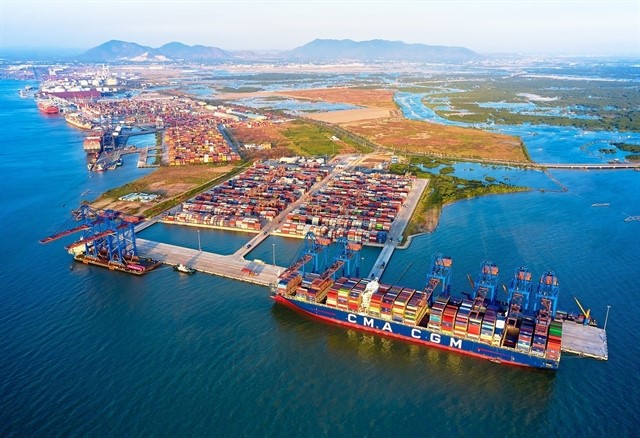Việt Nam needs policies to accelerate the greening of seaports for sustainable development in the future, according to experts at a seminar on green port development held on December 4 in HCM City.

Việt Nam needs policies to accelerate the greening of seaports for sustainable development in the future, according to experts at a seminar on green port development held on December 4 in HCM City.
Speaking at the event, deputy director of the Việt Nam Maritime Administration Hoàng Hồng Giang said around 30 out of 290 seaports have made green transformations. Some seaports have met the green port criteria, such as Tân Cảng Cát Lái, Cái Mép Thị Vải, Đà Nẵng port and Hải Phòng international container port.
That is a small number of seaports converting from a traditional model to a green framework, Giang said, adding that it needs more major programmes to change businesses' awareness about green transformation of seaports.
Võ Quốc Huy, chairman of Long An International Port, said Long An Port has carried out green steps, including investing in a shore power system for ships at the dock.
Long An Port has 500,000sq.m of warehouse space with solar panels, while it is also researching further digital and green transformations.
"The port has taken the first steps towards green transformation, but it still needs to learn from other major ports and partner with other domestic seaports to develop Việt Nam's green seaport system," said Huy.
Lieutenant Colonel Vũ Anh Tuấn, deputy head of the Technical Department, Saigon Newport Corporation, said that by 2050, the entire port must be green and switched to green power, but the power cost is too high.
"If the VNĐ12 trillion Lạch Huyện project is converted to a green and automated model, the investment will increase to nearly VNĐ30 trillion and even to VNĐ40 trillion," said Tuấn.
This is the biggest barrier to seaport enterprises, he said.
Therefore, he recommended that the Government should have supportive policies to help enterprises easily access green credits.
Regarding the issue of transport emissions, Phạm Hoài Trung, chairman of the Greego Co Ltd's advisory board, said that the businesses need to review fuel used at their supply chains and form a clearer greening roadmap. In addition, they can choose to cooperate with partners who are committed to green transformation.
At the seminar, Phan Hoàng Vũ, deputy general director of SSIT Port, said that on December 29, 2022, the Vietnam Maritime Administration issued a decision to announce Việt Nam's criteria for recognising green ports. This is a part of implementing the emission commitments that the Vietnamese Government signed at COP26.
Vũ said over the past two years, SSIT Port and other ports in Cái Mép port cluster, Bà Rịa - Vũng Tàu Province have reviewed operations and made plans and implemented actions to basically meet the green port criteria.
However, after the Covid-19 pandemic and sluggish growth in the world economy, many port and maritime enterprises face challenges in investing in green transformations, Vũ said.
Only some international ports have invested in the development of green ports from the beginning, basically meeting the green port criteria, he added.
"Currently, supportive and incentive policies are not clear, especially the mechanisms for promoting the seaports to meet the green port criteria. The policies will improve the competitiveness of Vietnamese seaports in the region and the world and also ensure the progress of greening seaports," he said.
He suggested that the State needs to issue specific targets for green energy conversion and develop carbon emission criteria.
At the same time, they need to increase service prices at deep-water ports, such as Cái Mép and Lạch Huyện, to attract investment in machinery and equipment to meet green conversion requirements.
They should also issue a list of shore power service prices and how those prices will be increased. That will encourage businesses to invest in the shore power supply systems and ships using electric engines.
Meanwhile, the Ministry of Industry and Trade should issue a clear policy to encourage businesses to use solar energy, reducing greenhouse gas emissions.
The State should provide tax incentives for imported equipment, machinery and technology for green transformation at seaports, he said.
Head of Public Relations and Shareholder Relations and in charge of coordinating the ESG board of Gemadept Group, Nguyễn Thị Thu Thảo, said that the Government needs to simplify administrative procedures and reduce fees and charges. She also recommended providing preferential loan packages for businesses to invest in green transformations.
The Government also needs to complete the legal framework to encourage green investment, creating a stable business environment.
Increasing the container lift on/off charge at ports is needed to encourage port businesses to invest in developing a national seaport infrastructure. That charge in Việt Nam is only 40 per cent of the regional average, she said. — VNS






